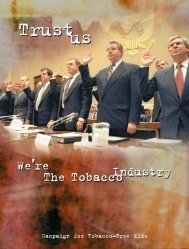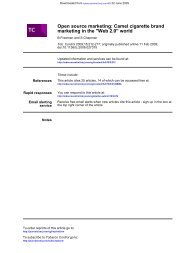National Cancer Prevention Policy - Tobacco Control Supersite
National Cancer Prevention Policy - Tobacco Control Supersite
National Cancer Prevention Policy - Tobacco Control Supersite
Create successful ePaper yourself
Turn your PDF publications into a flip-book with our unique Google optimized e-Paper software.
Workforce development<br />
Recruitment and training<br />
Given the focus on policy and regulation, the <strong>National</strong> <strong>Tobacco</strong> Strategy has identified a<br />
need to attract more people from legal, economic, public policy and scientific disciplines<br />
to crucial research and policy jobs. In addition, the importance of the public receiving<br />
accurate information about the health risks of smoking and the effectiveness of various<br />
treatments, policies and programs requires more people skilled in media relations.<br />
Continuing education<br />
As well as the behavioural aspects of smoking, people working in tobacco control need<br />
to better understand the toxicology and epidemiology of tobacco use and the social,<br />
economic and legal aspects of tobacco control. Training for health professionals must<br />
also be addressed as part of a comprehensive policy to treat tobacco dependence. To this<br />
end, the Australian <strong>National</strong> Training Authority has endorsed two units of competency in<br />
smoking cessation as part of the national population health training package.<br />
Access to crucial information<br />
Short term strategies endorsed in the <strong>National</strong> <strong>Tobacco</strong> Strategy are to:<br />
•<br />
•<br />
•<br />
•<br />
better synthesise information about developments internationally<br />
facilitate access to relevant research evidence<br />
facilitate sharing of ideas and resources between states and territories<br />
support biennial Australasian tobacco control conferences.<br />
Framework Convention on <strong>Tobacco</strong> <strong>Control</strong><br />
In 2004 the Australian Government ratified the World Health Organization Framework<br />
Convention on <strong>Tobacco</strong> <strong>Control</strong>. The objective of the convention was to protect present<br />
and future generations from the health, social, environmental and economic consequences<br />
of smoking and exposure to tobacco smoke. Countries that ratify the convention<br />
undertake to implement a range of measures relating to tobacco price and tax increases;<br />
tobacco advertising and sponsorship; regulation of tobacco products; tobacco product<br />
disclosure; packaging and labelling; education, communication, training and public<br />
awareness; cessation measures; illicit trade; sales to minors; support for economically<br />
viable alternatives; liability issues; and scientific and technical cooperation and exchange of<br />
information (WHO 2004).<br />
<strong>Tobacco</strong> Advertising Prohibition Act<br />
The <strong>Tobacco</strong> Advertising Prohibition Act was passed in 1992 to, according to section 3<br />
of the Act, ‘limit the exposure of the public to messages and images that may persuade<br />
them to start smoking, continue smoking, or use, or continue using, tobacco products’;<br />
and ‘to improve public health’. Evidence shows that the Act has worked effectively as a<br />
legislative instrument to limit the exposure of the Australian public to tobacco advertising<br />
through traditional mass media forms of marketing. However, a growing evidence base<br />
also shows that the Act has been ineffective in limiting exposure through other channels of<br />
communication, to which the tobacco industry has increasingly been turning since the Act<br />
was introduced.<br />
In August 2003, the Australian Department of Health and Ageing published an issues paper<br />
as part of the Government’s review of the <strong>Tobacco</strong> Advertising Prohibition Act, inviting<br />
submissions to seek ‘community views on the relevance of the Act’. The <strong>Cancer</strong> Council<br />
<strong>National</strong> <strong>Cancer</strong> <strong>Prevention</strong> <strong>Policy</strong> 2007 – 09<br />
33<br />
T o b a c c o




